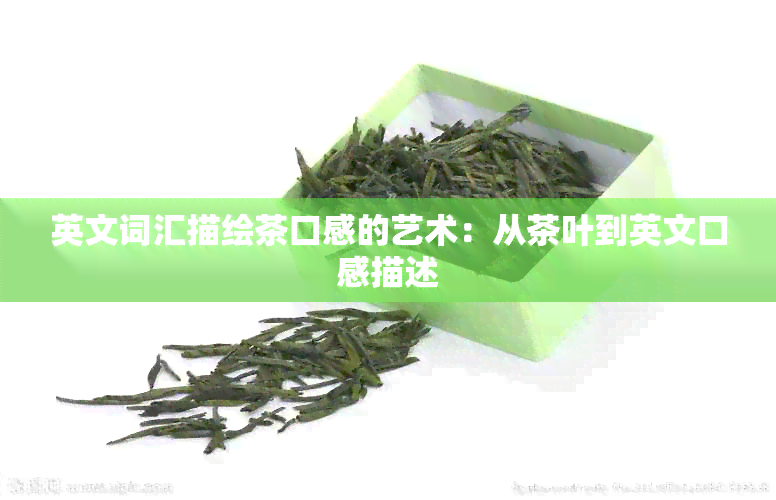Title: The Art of Describing Tea Soup Taste in English: From Tea Leaves to Sensory Lexicon

Introduction:
Tea, a beloved beverage across cultures, has been cherished for centuries not only for its refreshing taste but also for the meditative experience it offers. Describing the taste of tea in English requires a nuanced understanding of the sensory qualities that define different types of tea. This article delves into the art of describing tea soup taste in English, exploring the journey from the tea leaves to the intricate vocabulary used to convey the flavors, aromas, and textures that make each cup unique.
I. The Journey of Tea: From Leaf to Cup
1. The Origin and Types of Tea
Tea originated in China and has since spread across the world, taking on various forms and flavors. The primary categories of tea are green, white, yellow, oolong, black, and dark tea, each with its distinct characteristics derived from different levels of oxidation and processing.
2. The Process of Tea Making
The journey of tea begins with the careful plucking of leaves from the tea bush. These leaves undergo various processes such as withering, rolling, firing, and drying, which shape their final taste and aroma.
II. Sensory Qualities of Tea Soup: The Language of Taste
1. Flavor Profiles
The flavor of tea soup is a complex interplay of different taste sensations. Here are some key terms used to describe these profiles:
a. Pln and Thin: This refers to a tea that has a subtle taste, which quickly fades after the initial sip. Synonyms include dilute, weak, and insipid.
b. Astringency: This describes the sensation of a dry, puckering feeling in the mouth, often associated with tannins in the tea.
c. Bitter: A taste that is sharp and unpleasant, usually present in the first sip and sometimes lingering in the aftertaste.
d. Sweet Aftertaste: A pleasant, sweet sensation that follows the initial taste, indicating a well-rounded and balanced flavor.
2. Texture and Body
The texture of tea soup is an essential aspect of its sensory experience. Terms like full-bodied, thin, watery, and smooth are used to describe the mouthfeel of the tea.
a. Full-Bodied: A rich and substantial texture that is often associated with a higher concentration of flavors.
b. Thin: A tea that lacks body and feels light and watery on the palate.
c. Watery: A term used to describe a tea that is too dilute and lacks depth.
d. Smooth: A tea that feels soft and velvety on the tongue, without any rough or astringent sensation.
3. Color and Clarity
The visual eal of tea soup is also a crucial aspect of its sensory experience. Terms like deep, light color, bright, dull, and suspension are used to describe the earance of the tea.
a. Deep: A tea with a rich, dark color that indicates depth and concentration.
b. Light Color: A tea with a pale hue, often resembling water.
c. Bright: A tea that is clear and transparent, reflecting a clean and pure quality.
d. Dull: A tea that lacks clarity and ears murky or unealing.
III. Describing Tea Soup: An Artistic Endeavor
1. The Craft of Description
Describing the taste of tea soup is an art that requires both sensory perception and linguistic precision. Here are some techniques used to capture the essence of tea:
a. Sensory Imagery: Using vivid language to evoke the taste, texture, and aroma of the tea.
b. Metaphors and Similes: Comparing the taste of tea to other familiar experiences to create a mental image.
c. Descriptive Language: Employing a rich vocabulary to convey the subtle nuances of flavor and texture.
2. Examples of English Vocabulary for Tea Soup Descriptions
- The first sip of white tea is like a gentle breeze on a summer day, with a hint of sweetness that lingers on the palate.
- The deep, amber-hued oolong tea offers a full-bodied experience, with a rich, roasted aroma and a velvety texture.
- The green tea is bright and refreshing, with a grassy aroma and a slightly bitter aftertaste that is balanced by a sweet aftertaste.
Conclusion:
The art of describing tea soup taste in English is a reflection of the intricate and nuanced nature of tea itself. By understanding the sensory qualities and employing a rich vocabulary, one can capture the essence of tea and share the experience of savoring this timeless beverage. From the tea leaves to the cup, the journey of tea is a celebration of culture, history, and the senses.

